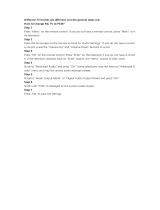
7
SPECIFICATIONS:
Type:
3-channel(ROTARY, STATIONARY-L,
STATIONARY-R)
Animation:
Horn Rotor, Digital Bass Rotor
Power
Output:
Rotary Horn 50W. Stationary Channels
75W×2. 200 watts total.
Speakers:
Compression Driver for Horn,
13cm Woofer × 2, 5cm Tweeter × 2.
Controls:
Volume: STA-L , STA-R , ROTARY ,
OVERDRIVE,TUBE MODE(SOFT-HARD),
8-position Function Selector
Touch Buttons: PRESET 1-2, MEMORY
Value: UP,DOWN
Stationary
Channel Mode:
MONO/STEREO
Display:
7-segment, 2-digit LED display
Terminals:
Leslie11-pin Socket,Leslie8-pin
Socket , ROTARY INPUT,LINE OUT
(STATIONARY-L,STATIONARY-R,
ROTARY-L, ROTARY-R), MIDI IN, MIDI
OUT, REMOTE (Remote Power for #2121)
External Speaker OUT.
Foot
Switch:
Foot Switch 1(PRESET),Foot Switch 2
(SLOW/FAST/STOP)
Powre
Consumption:
AC 120V,220-230V,230-240V 190W.
Dimensions:
51(W)×52(D)×33(H) cm
Weight:
23 kg
Optional
Accessories:
Stationary-Unit #2121, Leslie 11-pin Cable(LC11-7M),
Leslie 8-pin Cable (LC8-7M), Stand Adapter(LSA-21),
Foot Switch (FS-9H),Speaker Stand(TS-70B).
External Speaker System(LPS-21)
to insure
your
enjoyment
of
performing
music.
The Leslie
model 2101mk2 contain
wo
otors to produce
the world-renowned Leslie Speaker "Sound-In-Motion
®
."
The sound is "separated" with the highs reproduced
by a horn rotor and the lows
reproduced by a two 5" speakers
with electronic rotor capability.
Both the mechanical and electronic rotors can be operated
in two modes - Fast (Tremolo) or Slow (Chorale).
In addition, there is a stationary channel designed to
accommodate the audio signal from another sound
source such as a synthesizer or external sound module.
This audio signal is handled by three speakers
-the two 13cm speakers which also handle
the lower frequencies for the rotary channel,
and two 5cm dome tweeters for the high frequencies.
high
lev el
2"tweeter
5"woofer
5"woofer
2"tweeter
treble driver
variable speed
horn rotor
Lch
amp
75w
Rch
amp
75w
horn
amp
50w
DSP
crossover
network
DSP rotary
simulator
above
fc
below
fc
volume controls
*fc is crossover frequency
700,
800,1KHz
*Woofer doesn't sound when the
external speaker is connected
.
rotary
Lch
L/mono
L/mono
Lineout
EXT.Speaker
11pin leslie connector
low rotary
stationary & bass
sta tio n ary
Rc h
Rch
Rch
line amp line amp
External Speaker
terminal
Lch
station ar y
Rc h
rotary
Line in
middle
lev el
low
lev el
tube amp
tube is off

























